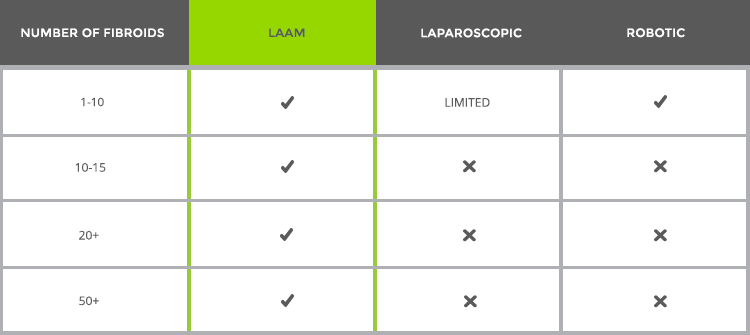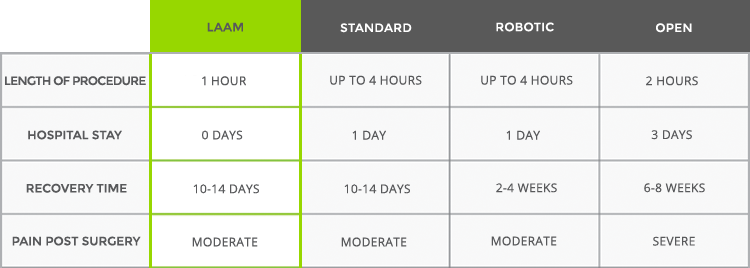
Myomectomy


Fibroids are non-cancerous growths that originate in the muscle of the womb.

What is a myomectomy?
A myomectomy is a surgical procedure to remove uterine fibroids, noncancerous tumors, without removing the uterus.
Depending on the location of the fibroids, the myomectomy can be done through the pelvic area or through the vagina and cervix.
Removing fibroids may enable a woman to get pregnant after the surgery.
Why would a woman need to undergo a myomectomy to treat fibroids?
A woman may choose to undergo a myomectomy to remove her uterine fibroids if she is experiencing aggravating symptoms from those fibroids, and she would like to retain her uterus for personal or reproductive reasons.
Depending on the location and size of a woman’s fibroids, these growths can interfere with conception, prevent implantation of a fertilized egg, or obstruct the fallopian tubes, preventing the embryo from passing into the uterine cavity and implanting on the endometrial lining.
Fibroids can also cause problems during pregnancy, including affecting the blood flow and preventing the fetus from growing properly and causing pre-term labor and birth.
To prevent these problems, women with fibroids who want to become pregnant should consider a myomectomy to remove the fibroids. In many cases, infertility specialists will refer patients for this surgery before attempting in vitro fertilization (IVF).
What are the different ways that a myomectomy is performed?
Depending on the size, number and location of your fibroids, physicians use different surgical approaches such as open abdominal surgery or minimally invasive laparoscopic surgery.
- Open myomectomy – the most commonly performed surgery – is often not the best solution. It requires either making a horizontal incision above the pubic bone or a vertical incision from just below the navel to the pubic bone. The benefit of open procedures is all fibroids can be removed from all locations, and the uterus can be properly closed to heal prior to attempting to conceive a child. However, a major disadvantage is a much larger incision, resulting in more pain and longer recovery times of 6 to 8 weeks. There is a much higher rate of complications as well.
- Laparoscopic or robotic myomectomies are minimally invasive procedures that can remove fibroids on stalks or from the outside the uterus without too much difficulty, when performed by a well-trained laparoscopic surgeon. However, these procedures present challenges when the fibroids are very large or there are large numbers of fibroids in the uterus. Other disadvantages include the time involved in performing these surgeries, the potential for heavy bleeding and the potential that all the fibroids will not be removed. There is also the risk that the uterus will not heal properly due to lack of access to incisions for effective repair.
Additional Disadvantage: During some laparoscopic procedures, surgeons may choose to use a power morcellator, a device used to divide up and remove large masses during laparoscopic procedures. The Food and Drug Administration (FDA) now requires surgeons to tell patients if they will use this device because of the potential for morcellators to spread cells of a hidden uterine cancer called sarcoma through the abdomen and pelvis during surgery.
- LAAM-BUAO, an innovative GYN surgical technique, was invented by the surgeons at The Center for Innovative GYN Care to overcome the challenges and disadvantages of other myomectomy surgeries. LAAM takes the best elements of both laparoscopic and open approaches for fibroid removal. LAAM (Laparoscopic Assisted Abdominal Myomectomy) entails two small incisions, one at the belly button and one at the bikini line. It is specifically designed for women who are seeking fertility. Women who are past childbearing may not be candidates for LAAM.
- BENEFITS OF LAAM: LAAM is not limited by fibroid size, number, or location. BUAO (Bilateral Uterine Artery Occlusion) is used to control bleeding during the procedure so the surgery is efficient with minimal blood loss. Due to the advantage of the surgeon being able to feel all of the fibroids, LAAM is the most thorough minimally invasive technique used for a myomectomy. Most LAAM procedures are done in an outpatient setting, and patients are able to return to their lives sooner than with open procedures.
- LAAM-BUAO is a more convenient surgery. Generally, the procedure takes approximately one hour and can be performed as an outpatient procedure, with shorter recovery times and less complication. By comparison, standard open procedures are up to four hours and require a hospital stay.
MYOMECTOMY TECHNIQUES AND FIBROID LOCATION
(Note, open procedures can remove all fibroids, but pain and recovery time are increased.) Learn more about fibroids and where they can be located.

MYOMECTOMY TECHNIQUES AND FIBROID SIZE

MYOMECTOMY TECHNIQUES AND NUMBER OF FIBROIDS

What are the major risks associated with a myomectomy?
Like any surgical procedure, myomectomy is associated with certain risks. These may include excessive blood loss, an infection requiring antibiotic treatment, developing scar tissue, and childbirth complications. In some cases, myomectomy results in injuries to internal organs and structures, such as damaging the ureter, which is the tube that transports urine from the kidney to the bladder. When this happens, additional corrective surgery is required. Choosing a GYN surgical specialist will greatly reduce your risk for such complications.
How long is recovery?
Recovery times vary from 10 days to 6-8 weeks depending on the type of surgery. This chart details recovery time for a variety of surgical techniques.

What kind of scars will I have?
The extent of your scarring is determined by the number and size of incisions. Innovative procedures, such as LAAM, minimize scarring.
What should I ask my doctor or OB-GYN if he/she recommends a myomectomy?
Before undergoing surgery, you will likely have many questions for your doctor or OB-GYN. Below are some recommended questions to ask – and background information to help you weigh the answers. You can also download a printable version of these questions.
HOW WILL THE SURGERY BE PERFORMED?
There are two main surgical treatment options for removing fibroids: a myomectomy, which only removes the fibroids, and a hysterectomy, which removes the uterus and fibroids. The type of surgery you choose should be based on your individual health concerns and desire to have children in the future.
Within these two surgical options, OB-GYNs also perform a wide range of surgical techniques with significantly different incision lengths, recovery times, and risk of complications. For example, unlike standard laparoscopic and robotic techniques, a new myomectomy procedure called LAAM-BUAO developed at The Center for Innovative GYN Care, has no limitation to the location, size and quantity of fibroids it can safely remove. Other laparoscopic procedures can only remove smaller fibroids and those found in a limited number of locations. Be sure your physician is using the latest advances in minimally invasive GYN surgery, as explained in our myomectomy and hysterectomy pages.
IS OPEN SURGERY RECOMMENDED?
Open myomectomies are still the mostly commonly performed surgery to remove fibroids, but the major disadvantage with this type of approach is that it requires a much larger incision than new, minimally invasive techniques, resulting in longer hospital stays, more pain during recovery and longer recovery times – patients often need six to eight weeks to recover. A LAAM procedure; however, can be conducted in an outpatient setting with no hospital stay, and women generally recover in 10-14 days.
HOW MANY TIMES HAS HE/SHE PERFORMED THIS SURGERY?
When it comes to any form of surgery, training, skill and practice matter, which is why GYN surgeons who specialize in minimally invasive surgery are the most qualified. The reality is that OB-GYNs are highly skilled obstetric practitioners, but very few perform GYN surgeries often enough to be surgical specialists. This is borne out by studies, which find that GYN surgery is commonly a secondary component of what an OB-GYN does.
WHAT HAVE OTHER PATIENTS EXPERIENCED AFTER THIS PROCEDURE?
Ask specific questions about recovery times and hospital stays. New, innovative procedures can be performed in an outpatient setting and generally require only 10-14 days to recover, not six to eight weeks.
HAS HE/SHE RECEIVED FELLOWSHIP TRAINING IN MINIMALLY INVASIVE GYN SURGERY?
While most OB-GYNs are highly trusted generalists, they spend most of their time focusing on obstetrics and basic GYN care and therefore, perform specialized GYN surgeries rarely. Be sure to choose a surgeon who has received comprehensive training and performs many minimally invasive surgeries to remove fibroids each year.
WILL POWER MORCELLATION BE USED TO REMOVE TISSUE DURING THE SURGERY?
This is an important question when considering fibroid removal surgery. The reason is because hidden uterine cancer called sarcoma can be spread through the abdomen and pelvis during surgery when the small motorized blades in these devices spin at high speed to cut the fibroids into small strips for removal. The Food and Drug Administration (FDA) now requires all surgeons to tell women in advance if the surgery involves a power morcellator and to get written consent before the surgery takes place. Today, new minimally invasive surgical options are available that do not involve power morcellation, such as LAAM-BUAO.
WILL ROBOTICS BE USED TO ASSIST WITH THE SURGERY?
Although the American Medical Association and other leading medical societies have issued statements discouraging robotic techniques due to much higher costs to patients without any medical advantages, robotics continue to be used in GYN surgeries. This is because robotic procedures “enable” an OB-GYN not well trained in laparoscopic GYN surgical techniques to complete a procedure through a “minimally invasive” approach. This is why women should ask if robotics will be used and seek a specially trained surgeon able to perform the latest minimally invasive surgical techniques without using robotics.
WHAT IS MY ANTICIPATED RECOVERY TIME?
Patients who undergo myomectomies using robotic and open techniques can expect recovery times of 2-4 weeks and 6-8 weeks respectively. By selecting newer, innovative techniques, patients can return to their normal daily routines in as little as 10-14 days.
WHAT ARE MY OTHER SURGICAL OPTIONS?
If your physician recommends an open or robotic procedure, ask why he or she would not recommend a conventional laparoscopic myomectomy or a newer technique like the LAAM-BUAO. This infographic explains all of the pros and cons of each procedure and helps patients advocate for the best care for themselves and their loved ones.


